MA514 Business Finance: Client-Focused Financial Planning Report
VerifiedAdded on 2023/06/11
|14
|3050
|142
Report
AI Summary
This report provides a comprehensive analysis of property investment in Melbourne, focusing on financial planning for a client. It includes calculations of property price changes using a five-year average method, income growth projections, and expense analysis to determine savings capacity. The r...

Running head: BUSINESS FINANCE
Business Finance
Name of the Student:
Name of the University:
Authors Note:
Business Finance
Name of the Student:
Name of the University:
Authors Note:
Paraphrase This Document
Need a fresh take? Get an instant paraphrase of this document with our AI Paraphraser
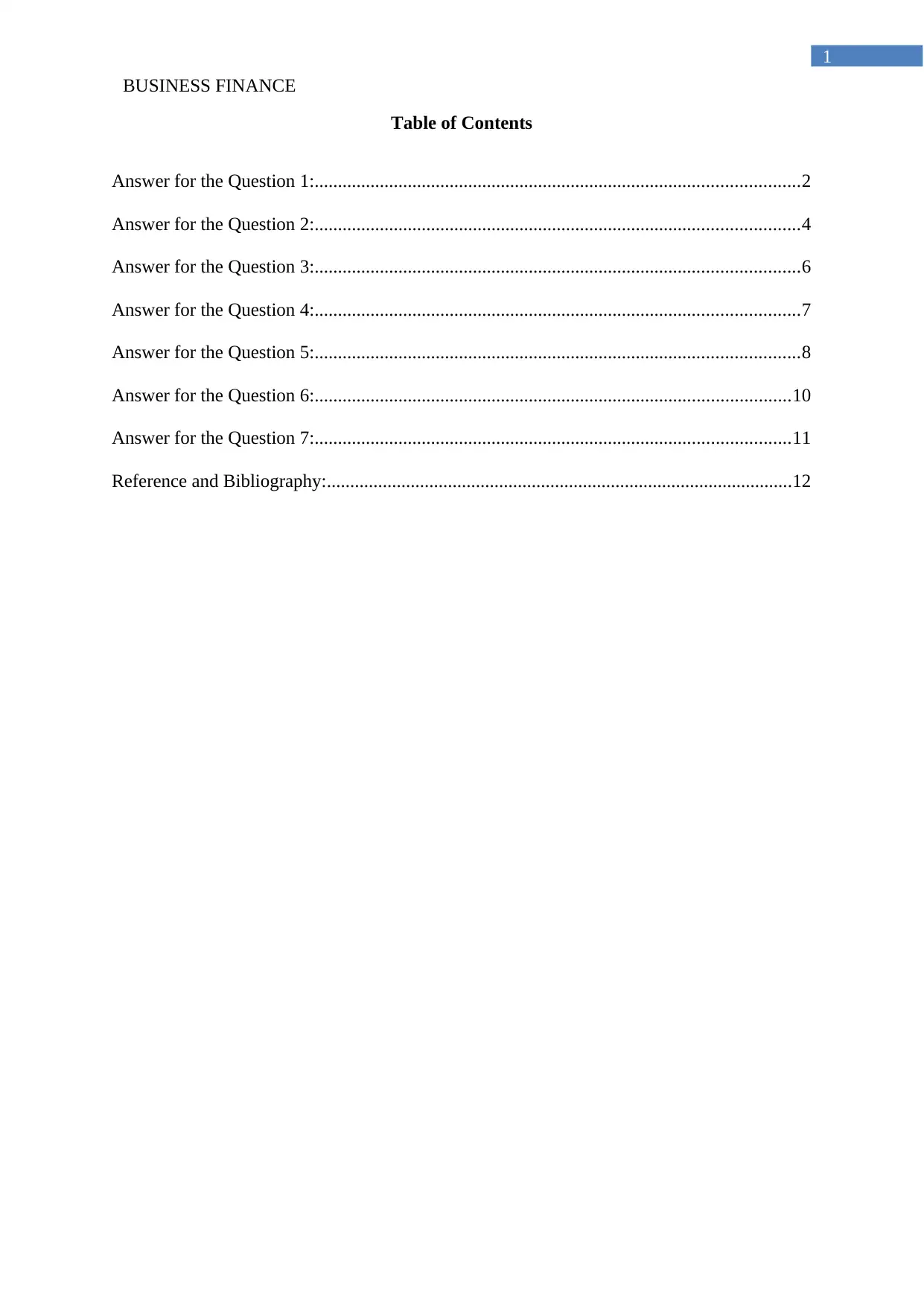
BUSINESS FINANCE
1
Table of Contents
Answer for the Question 1:........................................................................................................2
Answer for the Question 2:........................................................................................................4
Answer for the Question 3:........................................................................................................6
Answer for the Question 4:........................................................................................................7
Answer for the Question 5:........................................................................................................8
Answer for the Question 6:......................................................................................................10
Answer for the Question 7:......................................................................................................11
Reference and Bibliography:....................................................................................................12
1
Table of Contents
Answer for the Question 1:........................................................................................................2
Answer for the Question 2:........................................................................................................4
Answer for the Question 3:........................................................................................................6
Answer for the Question 4:........................................................................................................7
Answer for the Question 5:........................................................................................................8
Answer for the Question 6:......................................................................................................10
Answer for the Question 7:......................................................................................................11
Reference and Bibliography:....................................................................................................12
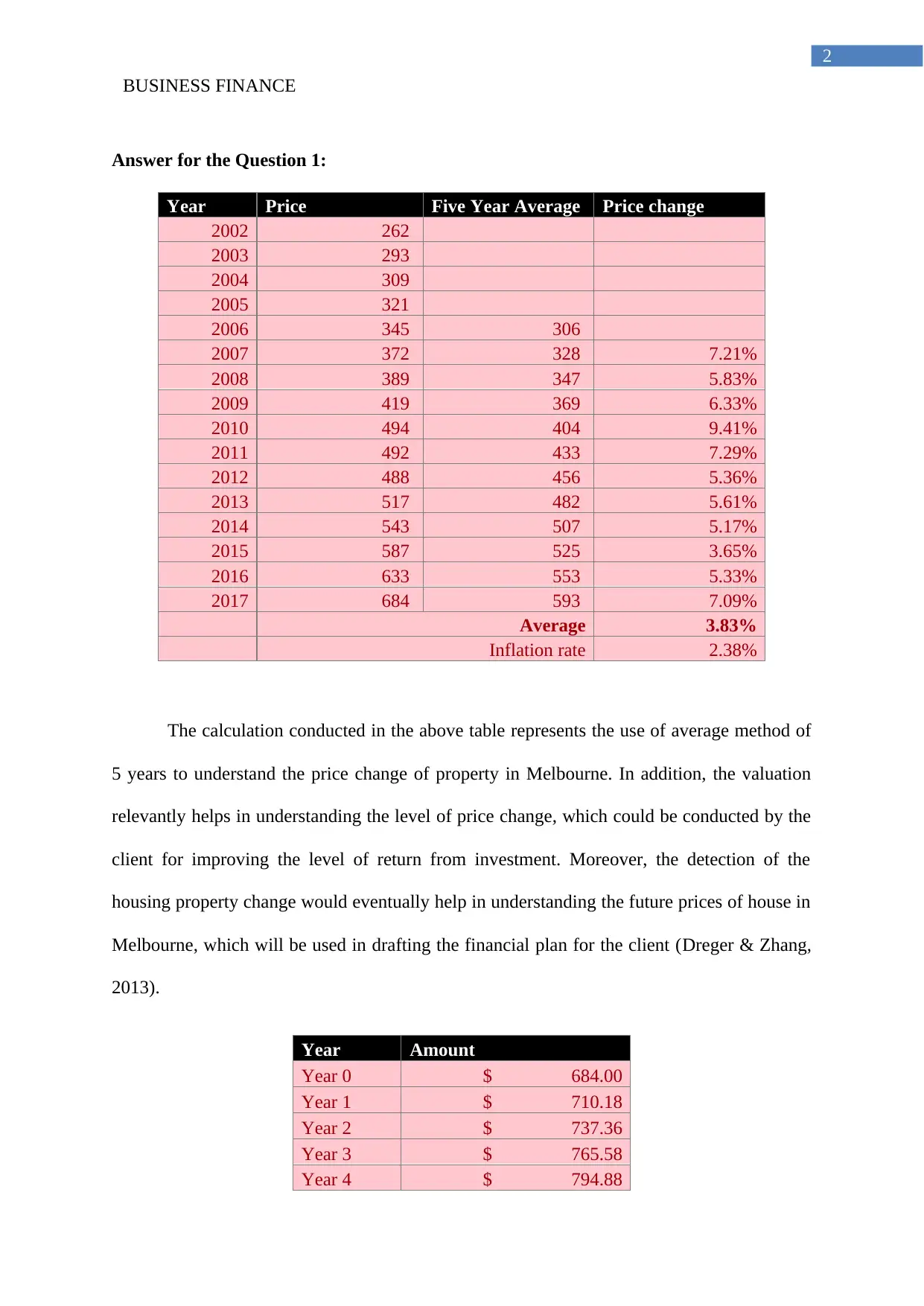
BUSINESS FINANCE
2
Answer for the Question 1:
Year Price Five Year Average Price change
2002 262
2003 293
2004 309
2005 321
2006 345 306
2007 372 328 7.21%
2008 389 347 5.83%
2009 419 369 6.33%
2010 494 404 9.41%
2011 492 433 7.29%
2012 488 456 5.36%
2013 517 482 5.61%
2014 543 507 5.17%
2015 587 525 3.65%
2016 633 553 5.33%
2017 684 593 7.09%
Average 3.83%
Inflation rate 2.38%
The calculation conducted in the above table represents the use of average method of
5 years to understand the price change of property in Melbourne. In addition, the valuation
relevantly helps in understanding the level of price change, which could be conducted by the
client for improving the level of return from investment. Moreover, the detection of the
housing property change would eventually help in understanding the future prices of house in
Melbourne, which will be used in drafting the financial plan for the client (Dreger & Zhang,
2013).
Year Amount
Year 0 $ 684.00
Year 1 $ 710.18
Year 2 $ 737.36
Year 3 $ 765.58
Year 4 $ 794.88
2
Answer for the Question 1:
Year Price Five Year Average Price change
2002 262
2003 293
2004 309
2005 321
2006 345 306
2007 372 328 7.21%
2008 389 347 5.83%
2009 419 369 6.33%
2010 494 404 9.41%
2011 492 433 7.29%
2012 488 456 5.36%
2013 517 482 5.61%
2014 543 507 5.17%
2015 587 525 3.65%
2016 633 553 5.33%
2017 684 593 7.09%
Average 3.83%
Inflation rate 2.38%
The calculation conducted in the above table represents the use of average method of
5 years to understand the price change of property in Melbourne. In addition, the valuation
relevantly helps in understanding the level of price change, which could be conducted by the
client for improving the level of return from investment. Moreover, the detection of the
housing property change would eventually help in understanding the future prices of house in
Melbourne, which will be used in drafting the financial plan for the client (Dreger & Zhang,
2013).
Year Amount
Year 0 $ 684.00
Year 1 $ 710.18
Year 2 $ 737.36
Year 3 $ 765.58
Year 4 $ 794.88
⊘ This is a preview!⊘
Do you want full access?
Subscribe today to unlock all pages.

Trusted by 1+ million students worldwide
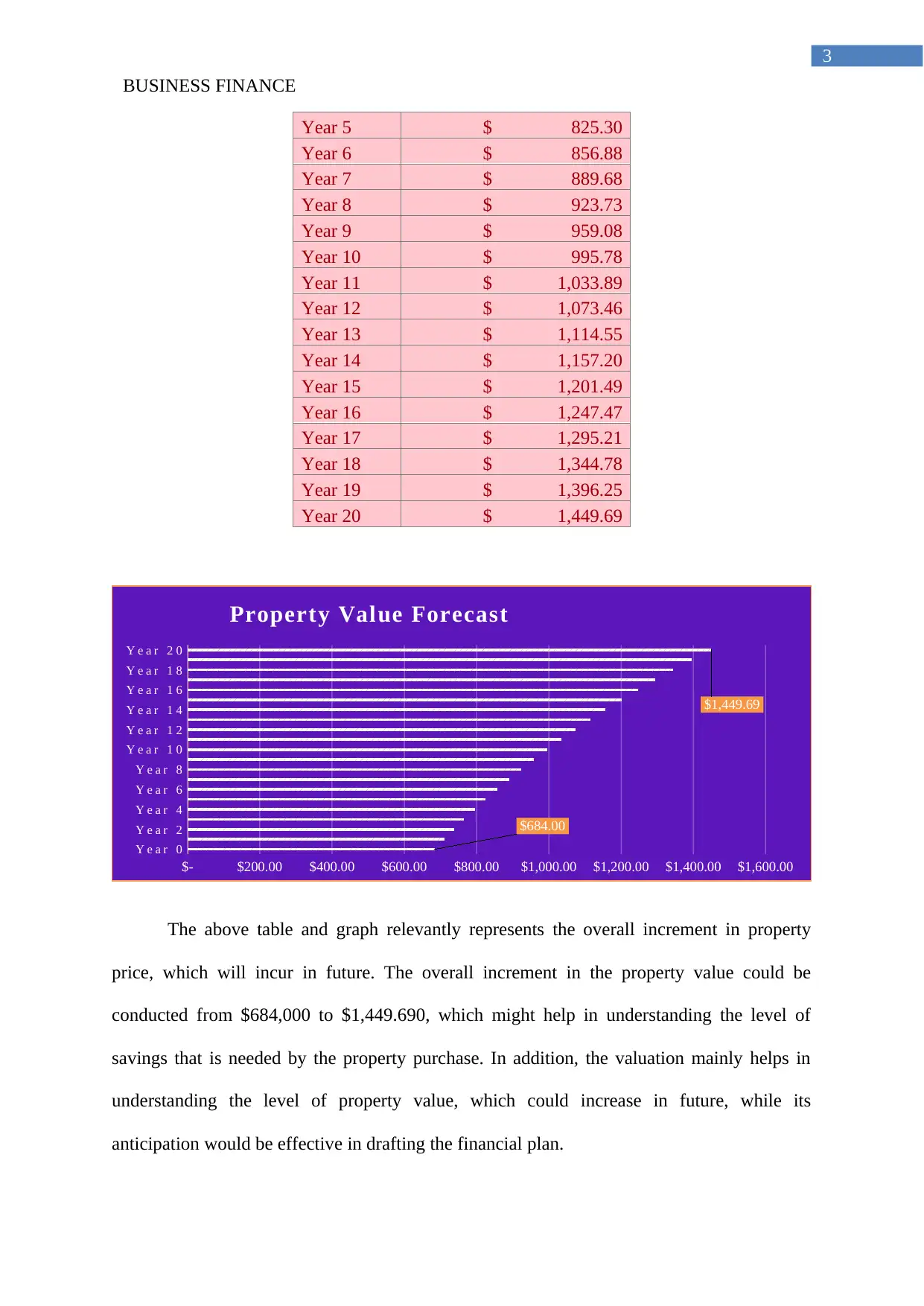
BUSINESS FINANCE
3
Year 5 $ 825.30
Year 6 $ 856.88
Year 7 $ 889.68
Year 8 $ 923.73
Year 9 $ 959.08
Year 10 $ 995.78
Year 11 $ 1,033.89
Year 12 $ 1,073.46
Year 13 $ 1,114.55
Year 14 $ 1,157.20
Year 15 $ 1,201.49
Year 16 $ 1,247.47
Year 17 $ 1,295.21
Year 18 $ 1,344.78
Year 19 $ 1,396.25
Year 20 $ 1,449.69
Y e a r 0
Y e a r 2
Y e a r 4
Y e a r 6
Y e a r 8
Y e a r 1 0
Y e a r 1 2
Y e a r 1 4
Y e a r 1 6
Y e a r 1 8
Y e a r 2 0
$- $200.00 $400.00 $600.00 $800.00 $1,000.00 $1,200.00 $1,400.00 $1,600.00
$684.00
$1,449.69
Property Value Forecast
The above table and graph relevantly represents the overall increment in property
price, which will incur in future. The overall increment in the property value could be
conducted from $684,000 to $1,449.690, which might help in understanding the level of
savings that is needed by the property purchase. In addition, the valuation mainly helps in
understanding the level of property value, which could increase in future, while its
anticipation would be effective in drafting the financial plan.
3
Year 5 $ 825.30
Year 6 $ 856.88
Year 7 $ 889.68
Year 8 $ 923.73
Year 9 $ 959.08
Year 10 $ 995.78
Year 11 $ 1,033.89
Year 12 $ 1,073.46
Year 13 $ 1,114.55
Year 14 $ 1,157.20
Year 15 $ 1,201.49
Year 16 $ 1,247.47
Year 17 $ 1,295.21
Year 18 $ 1,344.78
Year 19 $ 1,396.25
Year 20 $ 1,449.69
Y e a r 0
Y e a r 2
Y e a r 4
Y e a r 6
Y e a r 8
Y e a r 1 0
Y e a r 1 2
Y e a r 1 4
Y e a r 1 6
Y e a r 1 8
Y e a r 2 0
$- $200.00 $400.00 $600.00 $800.00 $1,000.00 $1,200.00 $1,400.00 $1,600.00
$684.00
$1,449.69
Property Value Forecast
The above table and graph relevantly represents the overall increment in property
price, which will incur in future. The overall increment in the property value could be
conducted from $684,000 to $1,449.690, which might help in understanding the level of
savings that is needed by the property purchase. In addition, the valuation mainly helps in
understanding the level of property value, which could increase in future, while its
anticipation would be effective in drafting the financial plan.
Paraphrase This Document
Need a fresh take? Get an instant paraphrase of this document with our AI Paraphraser
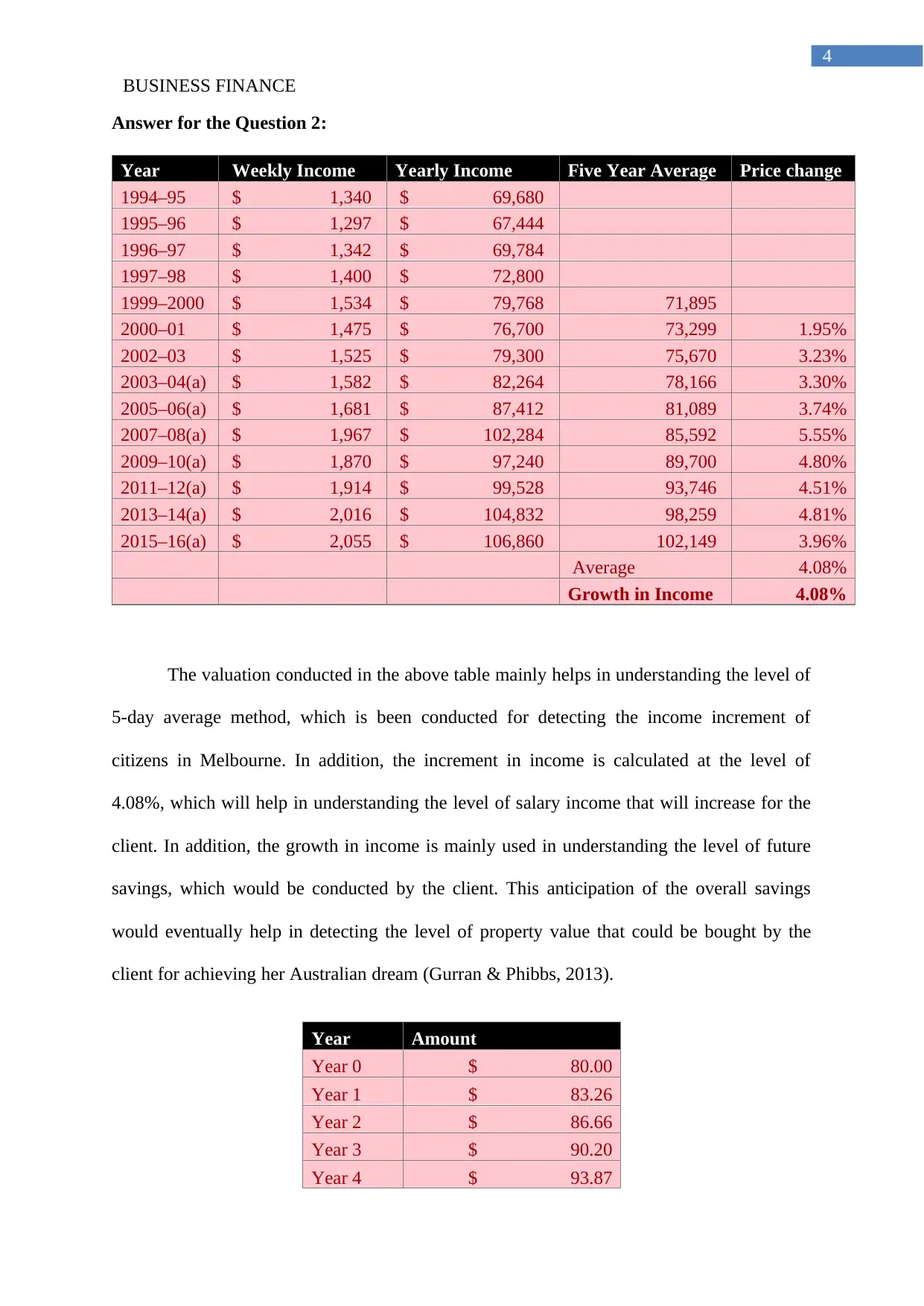
BUSINESS FINANCE
4
Answer for the Question 2:
Year Weekly Income Yearly Income Five Year Average Price change
1994–95 $ 1,340 $ 69,680
1995–96 $ 1,297 $ 67,444
1996–97 $ 1,342 $ 69,784
1997–98 $ 1,400 $ 72,800
1999–2000 $ 1,534 $ 79,768 71,895
2000–01 $ 1,475 $ 76,700 73,299 1.95%
2002–03 $ 1,525 $ 79,300 75,670 3.23%
2003–04(a) $ 1,582 $ 82,264 78,166 3.30%
2005–06(a) $ 1,681 $ 87,412 81,089 3.74%
2007–08(a) $ 1,967 $ 102,284 85,592 5.55%
2009–10(a) $ 1,870 $ 97,240 89,700 4.80%
2011–12(a) $ 1,914 $ 99,528 93,746 4.51%
2013–14(a) $ 2,016 $ 104,832 98,259 4.81%
2015–16(a) $ 2,055 $ 106,860 102,149 3.96%
Average 4.08%
Growth in Income 4.08%
The valuation conducted in the above table mainly helps in understanding the level of
5-day average method, which is been conducted for detecting the income increment of
citizens in Melbourne. In addition, the increment in income is calculated at the level of
4.08%, which will help in understanding the level of salary income that will increase for the
client. In addition, the growth in income is mainly used in understanding the level of future
savings, which would be conducted by the client. This anticipation of the overall savings
would eventually help in detecting the level of property value that could be bought by the
client for achieving her Australian dream (Gurran & Phibbs, 2013).
Year Amount
Year 0 $ 80.00
Year 1 $ 83.26
Year 2 $ 86.66
Year 3 $ 90.20
Year 4 $ 93.87
4
Answer for the Question 2:
Year Weekly Income Yearly Income Five Year Average Price change
1994–95 $ 1,340 $ 69,680
1995–96 $ 1,297 $ 67,444
1996–97 $ 1,342 $ 69,784
1997–98 $ 1,400 $ 72,800
1999–2000 $ 1,534 $ 79,768 71,895
2000–01 $ 1,475 $ 76,700 73,299 1.95%
2002–03 $ 1,525 $ 79,300 75,670 3.23%
2003–04(a) $ 1,582 $ 82,264 78,166 3.30%
2005–06(a) $ 1,681 $ 87,412 81,089 3.74%
2007–08(a) $ 1,967 $ 102,284 85,592 5.55%
2009–10(a) $ 1,870 $ 97,240 89,700 4.80%
2011–12(a) $ 1,914 $ 99,528 93,746 4.51%
2013–14(a) $ 2,016 $ 104,832 98,259 4.81%
2015–16(a) $ 2,055 $ 106,860 102,149 3.96%
Average 4.08%
Growth in Income 4.08%
The valuation conducted in the above table mainly helps in understanding the level of
5-day average method, which is been conducted for detecting the income increment of
citizens in Melbourne. In addition, the increment in income is calculated at the level of
4.08%, which will help in understanding the level of salary income that will increase for the
client. In addition, the growth in income is mainly used in understanding the level of future
savings, which would be conducted by the client. This anticipation of the overall savings
would eventually help in detecting the level of property value that could be bought by the
client for achieving her Australian dream (Gurran & Phibbs, 2013).
Year Amount
Year 0 $ 80.00
Year 1 $ 83.26
Year 2 $ 86.66
Year 3 $ 90.20
Year 4 $ 93.87
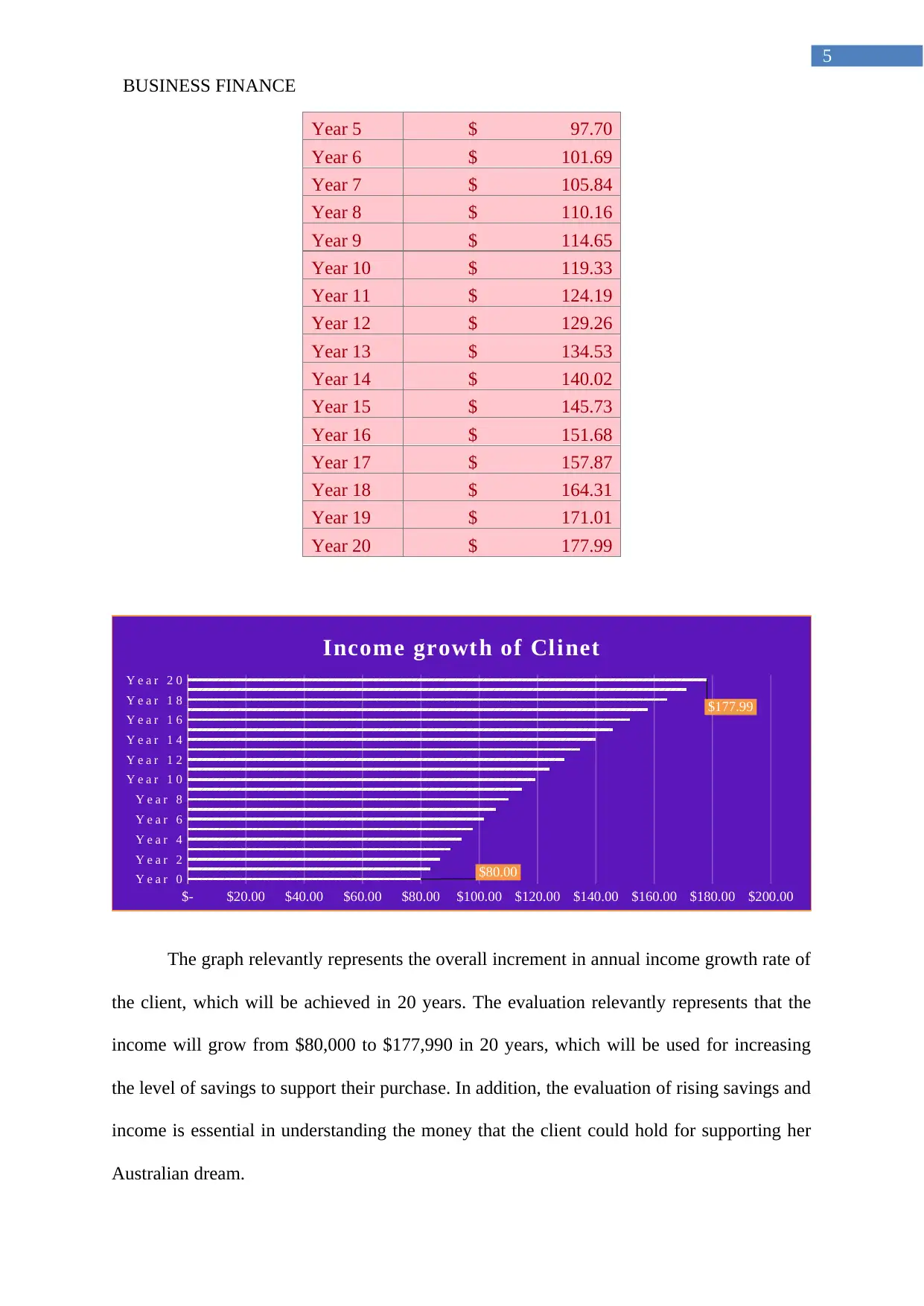
BUSINESS FINANCE
5
Year 5 $ 97.70
Year 6 $ 101.69
Year 7 $ 105.84
Year 8 $ 110.16
Year 9 $ 114.65
Year 10 $ 119.33
Year 11 $ 124.19
Year 12 $ 129.26
Year 13 $ 134.53
Year 14 $ 140.02
Year 15 $ 145.73
Year 16 $ 151.68
Year 17 $ 157.87
Year 18 $ 164.31
Year 19 $ 171.01
Year 20 $ 177.99
Y e a r 0
Y e a r 2
Y e a r 4
Y e a r 6
Y e a r 8
Y e a r 1 0
Y e a r 1 2
Y e a r 1 4
Y e a r 1 6
Y e a r 1 8
Y e a r 2 0
$- $20.00 $40.00 $60.00 $80.00 $100.00 $120.00 $140.00 $160.00 $180.00 $200.00
$80.00
$177.99
Income growth of Clinet
The graph relevantly represents the overall increment in annual income growth rate of
the client, which will be achieved in 20 years. The evaluation relevantly represents that the
income will grow from $80,000 to $177,990 in 20 years, which will be used for increasing
the level of savings to support their purchase. In addition, the evaluation of rising savings and
income is essential in understanding the money that the client could hold for supporting her
Australian dream.
5
Year 5 $ 97.70
Year 6 $ 101.69
Year 7 $ 105.84
Year 8 $ 110.16
Year 9 $ 114.65
Year 10 $ 119.33
Year 11 $ 124.19
Year 12 $ 129.26
Year 13 $ 134.53
Year 14 $ 140.02
Year 15 $ 145.73
Year 16 $ 151.68
Year 17 $ 157.87
Year 18 $ 164.31
Year 19 $ 171.01
Year 20 $ 177.99
Y e a r 0
Y e a r 2
Y e a r 4
Y e a r 6
Y e a r 8
Y e a r 1 0
Y e a r 1 2
Y e a r 1 4
Y e a r 1 6
Y e a r 1 8
Y e a r 2 0
$- $20.00 $40.00 $60.00 $80.00 $100.00 $120.00 $140.00 $160.00 $180.00 $200.00
$80.00
$177.99
Income growth of Clinet
The graph relevantly represents the overall increment in annual income growth rate of
the client, which will be achieved in 20 years. The evaluation relevantly represents that the
income will grow from $80,000 to $177,990 in 20 years, which will be used for increasing
the level of savings to support their purchase. In addition, the evaluation of rising savings and
income is essential in understanding the money that the client could hold for supporting her
Australian dream.
⊘ This is a preview!⊘
Do you want full access?
Subscribe today to unlock all pages.

Trusted by 1+ million students worldwide

BUSINESS FINANCE
6
Answer for the Question 3:
Particulars Monthly Yearly
Salary $ 6,666.67 $ 80,000.00
Expenses on Amenities $ 1,620.00 $ 19,440.00
Expenses on rent $ 1,580.00 $ 18,960.00
Total expense $ 3,200.00 $ 38,400.00
Tax $17,547.00
Savings $ 2,004.42 $ 24,053.00
The valuation conducted on the above table relevantly utilises the expenses that will
be incurred by the client on monthly and yearly basis. This type of expenses will directly
have impact on the savings capability of the client, which is evaluated to conduct the
purchases of property intended by the client. In addition, the evaluation also indicates the tax
paid by the client on yearly basis, which is expressed, as expenses and is conducted to derive
the overall savings of the client (Haslam McKenzie & Rowley, 2013).
Particulars Value
Max LVR 80%
Property Value $ 370,265.00
Loan from Bank $ 296,212.00
Deposit to bank $ 74,053.00
The calculation further entitled the client to understand the property value, which
could be bought from the current savings and income. The evaluation relevantly indicates that
house value of $370,265 can be bought by the client, where the total LVR will stand at 80%,
while the deposit to the bank will be at the level of $ 74,053. This would mainly help in
6
Answer for the Question 3:
Particulars Monthly Yearly
Salary $ 6,666.67 $ 80,000.00
Expenses on Amenities $ 1,620.00 $ 19,440.00
Expenses on rent $ 1,580.00 $ 18,960.00
Total expense $ 3,200.00 $ 38,400.00
Tax $17,547.00
Savings $ 2,004.42 $ 24,053.00
The valuation conducted on the above table relevantly utilises the expenses that will
be incurred by the client on monthly and yearly basis. This type of expenses will directly
have impact on the savings capability of the client, which is evaluated to conduct the
purchases of property intended by the client. In addition, the evaluation also indicates the tax
paid by the client on yearly basis, which is expressed, as expenses and is conducted to derive
the overall savings of the client (Haslam McKenzie & Rowley, 2013).
Particulars Value
Max LVR 80%
Property Value $ 370,265.00
Loan from Bank $ 296,212.00
Deposit to bank $ 74,053.00
The calculation further entitled the client to understand the property value, which
could be bought from the current savings and income. The evaluation relevantly indicates that
house value of $370,265 can be bought by the client, where the total LVR will stand at 80%,
while the deposit to the bank will be at the level of $ 74,053. This would mainly help in
Paraphrase This Document
Need a fresh take? Get an instant paraphrase of this document with our AI Paraphraser
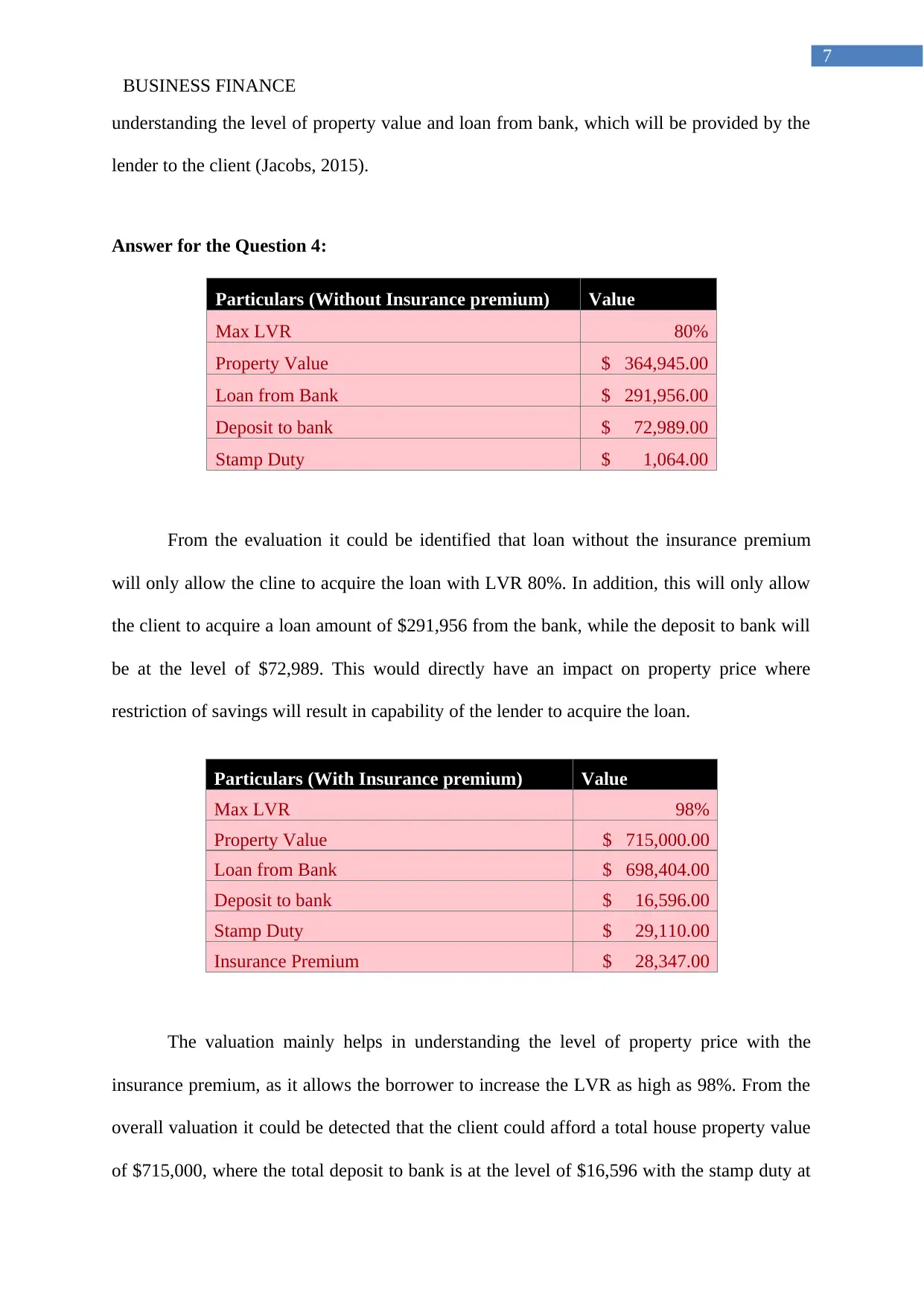
BUSINESS FINANCE
7
understanding the level of property value and loan from bank, which will be provided by the
lender to the client (Jacobs, 2015).
Answer for the Question 4:
Particulars (Without Insurance premium) Value
Max LVR 80%
Property Value $ 364,945.00
Loan from Bank $ 291,956.00
Deposit to bank $ 72,989.00
Stamp Duty $ 1,064.00
From the evaluation it could be identified that loan without the insurance premium
will only allow the cline to acquire the loan with LVR 80%. In addition, this will only allow
the client to acquire a loan amount of $291,956 from the bank, while the deposit to bank will
be at the level of $72,989. This would directly have an impact on property price where
restriction of savings will result in capability of the lender to acquire the loan.
Particulars (With Insurance premium) Value
Max LVR 98%
Property Value $ 715,000.00
Loan from Bank $ 698,404.00
Deposit to bank $ 16,596.00
Stamp Duty $ 29,110.00
Insurance Premium $ 28,347.00
The valuation mainly helps in understanding the level of property price with the
insurance premium, as it allows the borrower to increase the LVR as high as 98%. From the
overall valuation it could be detected that the client could afford a total house property value
of $715,000, where the total deposit to bank is at the level of $16,596 with the stamp duty at
7
understanding the level of property value and loan from bank, which will be provided by the
lender to the client (Jacobs, 2015).
Answer for the Question 4:
Particulars (Without Insurance premium) Value
Max LVR 80%
Property Value $ 364,945.00
Loan from Bank $ 291,956.00
Deposit to bank $ 72,989.00
Stamp Duty $ 1,064.00
From the evaluation it could be identified that loan without the insurance premium
will only allow the cline to acquire the loan with LVR 80%. In addition, this will only allow
the client to acquire a loan amount of $291,956 from the bank, while the deposit to bank will
be at the level of $72,989. This would directly have an impact on property price where
restriction of savings will result in capability of the lender to acquire the loan.
Particulars (With Insurance premium) Value
Max LVR 98%
Property Value $ 715,000.00
Loan from Bank $ 698,404.00
Deposit to bank $ 16,596.00
Stamp Duty $ 29,110.00
Insurance Premium $ 28,347.00
The valuation mainly helps in understanding the level of property price with the
insurance premium, as it allows the borrower to increase the LVR as high as 98%. From the
overall valuation it could be detected that the client could afford a total house property value
of $715,000, where the total deposit to bank is at the level of $16,596 with the stamp duty at

BUSINESS FINANCE
8
$29,110 and insurance premium at the level of $28,347. This relevantly indicates that the
client could effectively purchase high value property with the help of insurance premium and
fulfil her Australian dream (Lee, & Reed, 2013).
Answer for the Question 5:
Year
Property
price
Savings
Target 20% upfront Stamp duty Difference
0
$
684,000
$
74,053
$
136,800
$
31,868
$
(94,615)
1
$
710,178
$
99,411
$
142,036
$
12,876
$
(55,501)
2
$
737,357
$
126,142
$
147,471
$
13,752
$
(35,081)
3
$
765,577
$
154,174
$
153,115
$
14,661
$
(13,602)
4
$
794,876
$
183,561
$
158,975
$
15,605
$
8,981
5
$
825,297
$
214,375
$
165,059
$
16,584
$
32,731
6
$
856,883
$
246,692
$
171,377
$
17,602
$
57,713
7
$
889,677
$
280,589
$
177,935
$
18,658
$
83,996
8
$
923,726
$
316,151
$
184,745
$
19,755
$
111,650
9
$
959,078
$
353,462
$
191,816
$
20,894
$
140,752
10
$
995,784
$
392,613
$
199,157
$
22,076
$
171,380
11
$
1,033,894
$
433,698
$
206,779
$
23,304
$
203,616
12
$
1,073,462
$
476,817
$
214,692
$
24,578
$
237,546
13
$
1,114,545
$
522,071
$
222,909
$
25,902
$
273,260
14
$
1,157,200
$
569,569
$
231,440
$
27,276
$
310,854
15
$
1,201,488
$
619,424
$
240,298
$
28,702
$
350,424
16
$
1,247,470
$
671,753
$
249,494
$
30,184
$
392,075
17
$
1,295,213
$
726,679
$
259,043
$
31,721
$
435,915
18
$
1,344,782
$
784,331
$
268,956
$
33,318
$
482,056
8
$29,110 and insurance premium at the level of $28,347. This relevantly indicates that the
client could effectively purchase high value property with the help of insurance premium and
fulfil her Australian dream (Lee, & Reed, 2013).
Answer for the Question 5:
Year
Property
price
Savings
Target 20% upfront Stamp duty Difference
0
$
684,000
$
74,053
$
136,800
$
31,868
$
(94,615)
1
$
710,178
$
99,411
$
142,036
$
12,876
$
(55,501)
2
$
737,357
$
126,142
$
147,471
$
13,752
$
(35,081)
3
$
765,577
$
154,174
$
153,115
$
14,661
$
(13,602)
4
$
794,876
$
183,561
$
158,975
$
15,605
$
8,981
5
$
825,297
$
214,375
$
165,059
$
16,584
$
32,731
6
$
856,883
$
246,692
$
171,377
$
17,602
$
57,713
7
$
889,677
$
280,589
$
177,935
$
18,658
$
83,996
8
$
923,726
$
316,151
$
184,745
$
19,755
$
111,650
9
$
959,078
$
353,462
$
191,816
$
20,894
$
140,752
10
$
995,784
$
392,613
$
199,157
$
22,076
$
171,380
11
$
1,033,894
$
433,698
$
206,779
$
23,304
$
203,616
12
$
1,073,462
$
476,817
$
214,692
$
24,578
$
237,546
13
$
1,114,545
$
522,071
$
222,909
$
25,902
$
273,260
14
$
1,157,200
$
569,569
$
231,440
$
27,276
$
310,854
15
$
1,201,488
$
619,424
$
240,298
$
28,702
$
350,424
16
$
1,247,470
$
671,753
$
249,494
$
30,184
$
392,075
17
$
1,295,213
$
726,679
$
259,043
$
31,721
$
435,915
18
$
1,344,782
$
784,331
$
268,956
$
33,318
$
482,056
⊘ This is a preview!⊘
Do you want full access?
Subscribe today to unlock all pages.

Trusted by 1+ million students worldwide
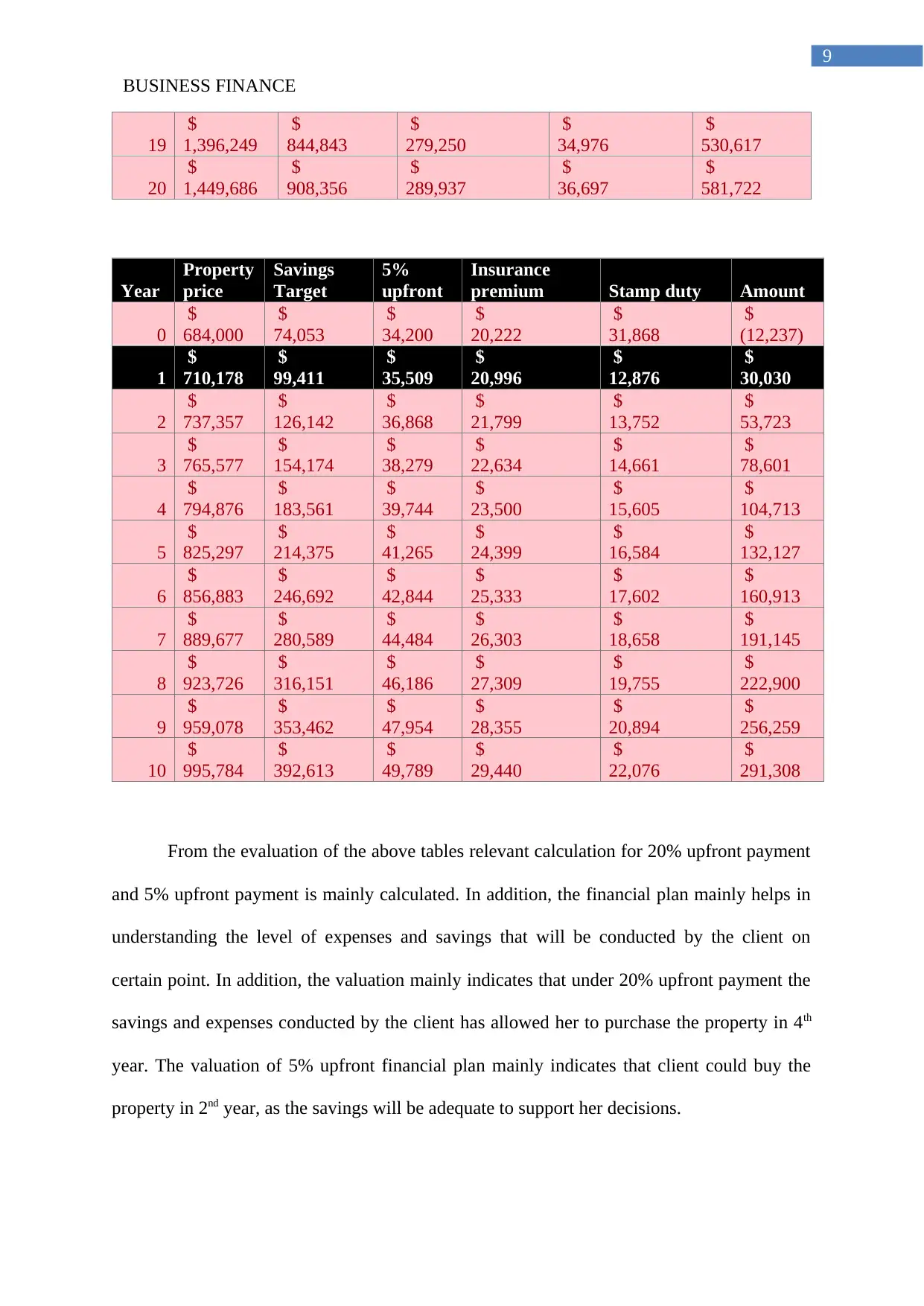
BUSINESS FINANCE
9
19
$
1,396,249
$
844,843
$
279,250
$
34,976
$
530,617
20
$
1,449,686
$
908,356
$
289,937
$
36,697
$
581,722
Year
Property
price
Savings
Target
5%
upfront
Insurance
premium Stamp duty Amount
0
$
684,000
$
74,053
$
34,200
$
20,222
$
31,868
$
(12,237)
1
$
710,178
$
99,411
$
35,509
$
20,996
$
12,876
$
30,030
2
$
737,357
$
126,142
$
36,868
$
21,799
$
13,752
$
53,723
3
$
765,577
$
154,174
$
38,279
$
22,634
$
14,661
$
78,601
4
$
794,876
$
183,561
$
39,744
$
23,500
$
15,605
$
104,713
5
$
825,297
$
214,375
$
41,265
$
24,399
$
16,584
$
132,127
6
$
856,883
$
246,692
$
42,844
$
25,333
$
17,602
$
160,913
7
$
889,677
$
280,589
$
44,484
$
26,303
$
18,658
$
191,145
8
$
923,726
$
316,151
$
46,186
$
27,309
$
19,755
$
222,900
9
$
959,078
$
353,462
$
47,954
$
28,355
$
20,894
$
256,259
10
$
995,784
$
392,613
$
49,789
$
29,440
$
22,076
$
291,308
From the evaluation of the above tables relevant calculation for 20% upfront payment
and 5% upfront payment is mainly calculated. In addition, the financial plan mainly helps in
understanding the level of expenses and savings that will be conducted by the client on
certain point. In addition, the valuation mainly indicates that under 20% upfront payment the
savings and expenses conducted by the client has allowed her to purchase the property in 4th
year. The valuation of 5% upfront financial plan mainly indicates that client could buy the
property in 2nd year, as the savings will be adequate to support her decisions.
9
19
$
1,396,249
$
844,843
$
279,250
$
34,976
$
530,617
20
$
1,449,686
$
908,356
$
289,937
$
36,697
$
581,722
Year
Property
price
Savings
Target
5%
upfront
Insurance
premium Stamp duty Amount
0
$
684,000
$
74,053
$
34,200
$
20,222
$
31,868
$
(12,237)
1
$
710,178
$
99,411
$
35,509
$
20,996
$
12,876
$
30,030
2
$
737,357
$
126,142
$
36,868
$
21,799
$
13,752
$
53,723
3
$
765,577
$
154,174
$
38,279
$
22,634
$
14,661
$
78,601
4
$
794,876
$
183,561
$
39,744
$
23,500
$
15,605
$
104,713
5
$
825,297
$
214,375
$
41,265
$
24,399
$
16,584
$
132,127
6
$
856,883
$
246,692
$
42,844
$
25,333
$
17,602
$
160,913
7
$
889,677
$
280,589
$
44,484
$
26,303
$
18,658
$
191,145
8
$
923,726
$
316,151
$
46,186
$
27,309
$
19,755
$
222,900
9
$
959,078
$
353,462
$
47,954
$
28,355
$
20,894
$
256,259
10
$
995,784
$
392,613
$
49,789
$
29,440
$
22,076
$
291,308
From the evaluation of the above tables relevant calculation for 20% upfront payment
and 5% upfront payment is mainly calculated. In addition, the financial plan mainly helps in
understanding the level of expenses and savings that will be conducted by the client on
certain point. In addition, the valuation mainly indicates that under 20% upfront payment the
savings and expenses conducted by the client has allowed her to purchase the property in 4th
year. The valuation of 5% upfront financial plan mainly indicates that client could buy the
property in 2nd year, as the savings will be adequate to support her decisions.
Paraphrase This Document
Need a fresh take? Get an instant paraphrase of this document with our AI Paraphraser
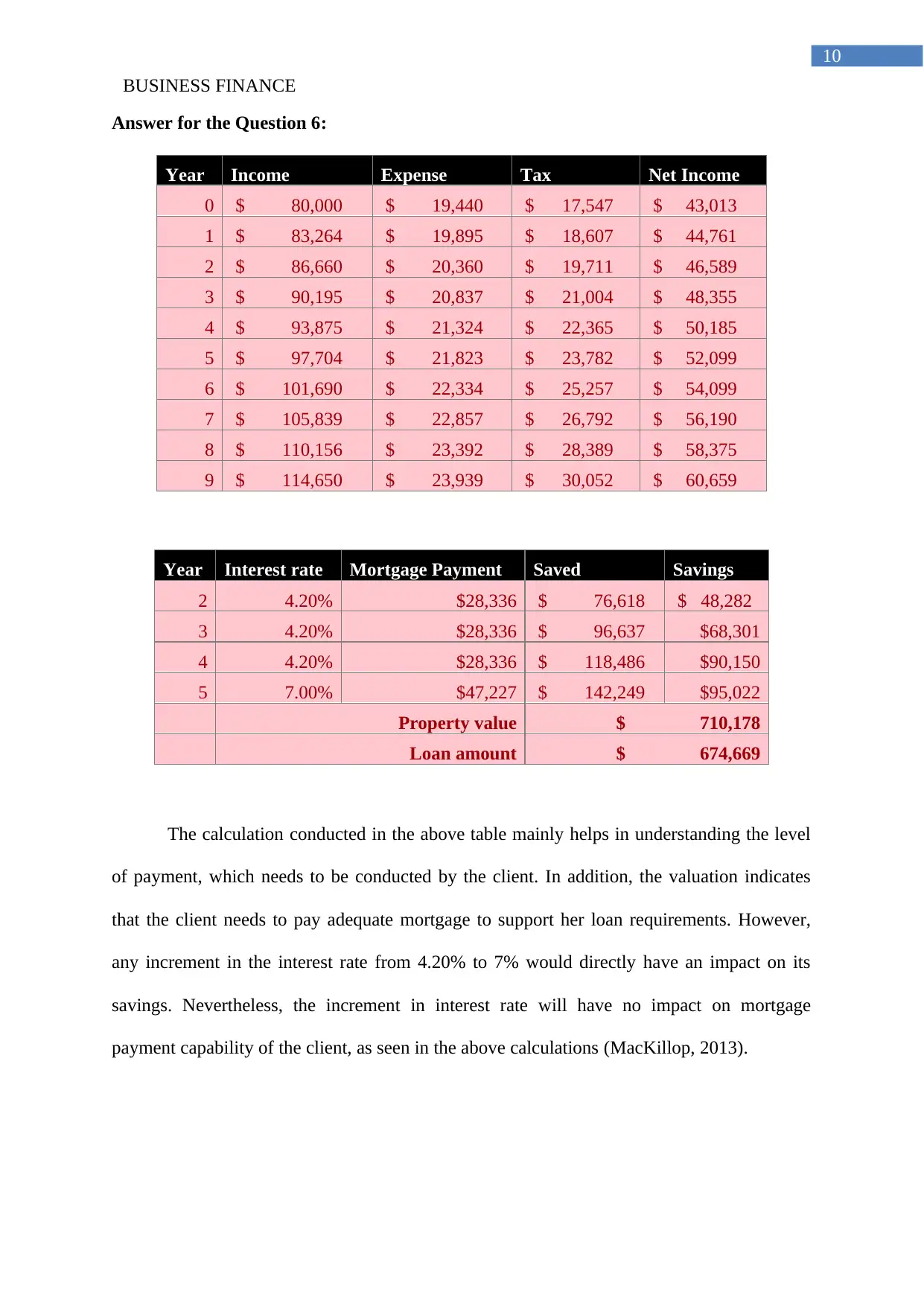
BUSINESS FINANCE
10
Answer for the Question 6:
Year Income Expense Tax Net Income
0 $ 80,000 $ 19,440 $ 17,547 $ 43,013
1 $ 83,264 $ 19,895 $ 18,607 $ 44,761
2 $ 86,660 $ 20,360 $ 19,711 $ 46,589
3 $ 90,195 $ 20,837 $ 21,004 $ 48,355
4 $ 93,875 $ 21,324 $ 22,365 $ 50,185
5 $ 97,704 $ 21,823 $ 23,782 $ 52,099
6 $ 101,690 $ 22,334 $ 25,257 $ 54,099
7 $ 105,839 $ 22,857 $ 26,792 $ 56,190
8 $ 110,156 $ 23,392 $ 28,389 $ 58,375
9 $ 114,650 $ 23,939 $ 30,052 $ 60,659
Year Interest rate Mortgage Payment Saved Savings
2 4.20% $28,336 $ 76,618 $ 48,282
3 4.20% $28,336 $ 96,637 $68,301
4 4.20% $28,336 $ 118,486 $90,150
5 7.00% $47,227 $ 142,249 $95,022
Property value $ 710,178
Loan amount $ 674,669
The calculation conducted in the above table mainly helps in understanding the level
of payment, which needs to be conducted by the client. In addition, the valuation indicates
that the client needs to pay adequate mortgage to support her loan requirements. However,
any increment in the interest rate from 4.20% to 7% would directly have an impact on its
savings. Nevertheless, the increment in interest rate will have no impact on mortgage
payment capability of the client, as seen in the above calculations (MacKillop, 2013).
10
Answer for the Question 6:
Year Income Expense Tax Net Income
0 $ 80,000 $ 19,440 $ 17,547 $ 43,013
1 $ 83,264 $ 19,895 $ 18,607 $ 44,761
2 $ 86,660 $ 20,360 $ 19,711 $ 46,589
3 $ 90,195 $ 20,837 $ 21,004 $ 48,355
4 $ 93,875 $ 21,324 $ 22,365 $ 50,185
5 $ 97,704 $ 21,823 $ 23,782 $ 52,099
6 $ 101,690 $ 22,334 $ 25,257 $ 54,099
7 $ 105,839 $ 22,857 $ 26,792 $ 56,190
8 $ 110,156 $ 23,392 $ 28,389 $ 58,375
9 $ 114,650 $ 23,939 $ 30,052 $ 60,659
Year Interest rate Mortgage Payment Saved Savings
2 4.20% $28,336 $ 76,618 $ 48,282
3 4.20% $28,336 $ 96,637 $68,301
4 4.20% $28,336 $ 118,486 $90,150
5 7.00% $47,227 $ 142,249 $95,022
Property value $ 710,178
Loan amount $ 674,669
The calculation conducted in the above table mainly helps in understanding the level
of payment, which needs to be conducted by the client. In addition, the valuation indicates
that the client needs to pay adequate mortgage to support her loan requirements. However,
any increment in the interest rate from 4.20% to 7% would directly have an impact on its
savings. Nevertheless, the increment in interest rate will have no impact on mortgage
payment capability of the client, as seen in the above calculations (MacKillop, 2013).

BUSINESS FINANCE
11
Answer for the Question 7:
The calculation conducted in the above financial plan mainly helps in understanding
the level of expenses and income that will be generated by the client. The evaluation is
mainly conducted on the basis income flow of the client, while any kind of extra increment in
expenses will result in fulfilment of the financial plan. The changes in inflation rate and
property price will have an impact on the financial position of the client, which will directly
have negative effect on savings of the client. The overall decline in income of the client will
have a drastic impact on the functionality of the financial plan, as the client will not be able to
support her living expense and mortgage payment, Hence, the main requirements of the
financial plan is to maintain adequate income thought out the life of mortgage.
11
Answer for the Question 7:
The calculation conducted in the above financial plan mainly helps in understanding
the level of expenses and income that will be generated by the client. The evaluation is
mainly conducted on the basis income flow of the client, while any kind of extra increment in
expenses will result in fulfilment of the financial plan. The changes in inflation rate and
property price will have an impact on the financial position of the client, which will directly
have negative effect on savings of the client. The overall decline in income of the client will
have a drastic impact on the functionality of the financial plan, as the client will not be able to
support her living expense and mortgage payment, Hence, the main requirements of the
financial plan is to maintain adequate income thought out the life of mortgage.
⊘ This is a preview!⊘
Do you want full access?
Subscribe today to unlock all pages.

Trusted by 1+ million students worldwide
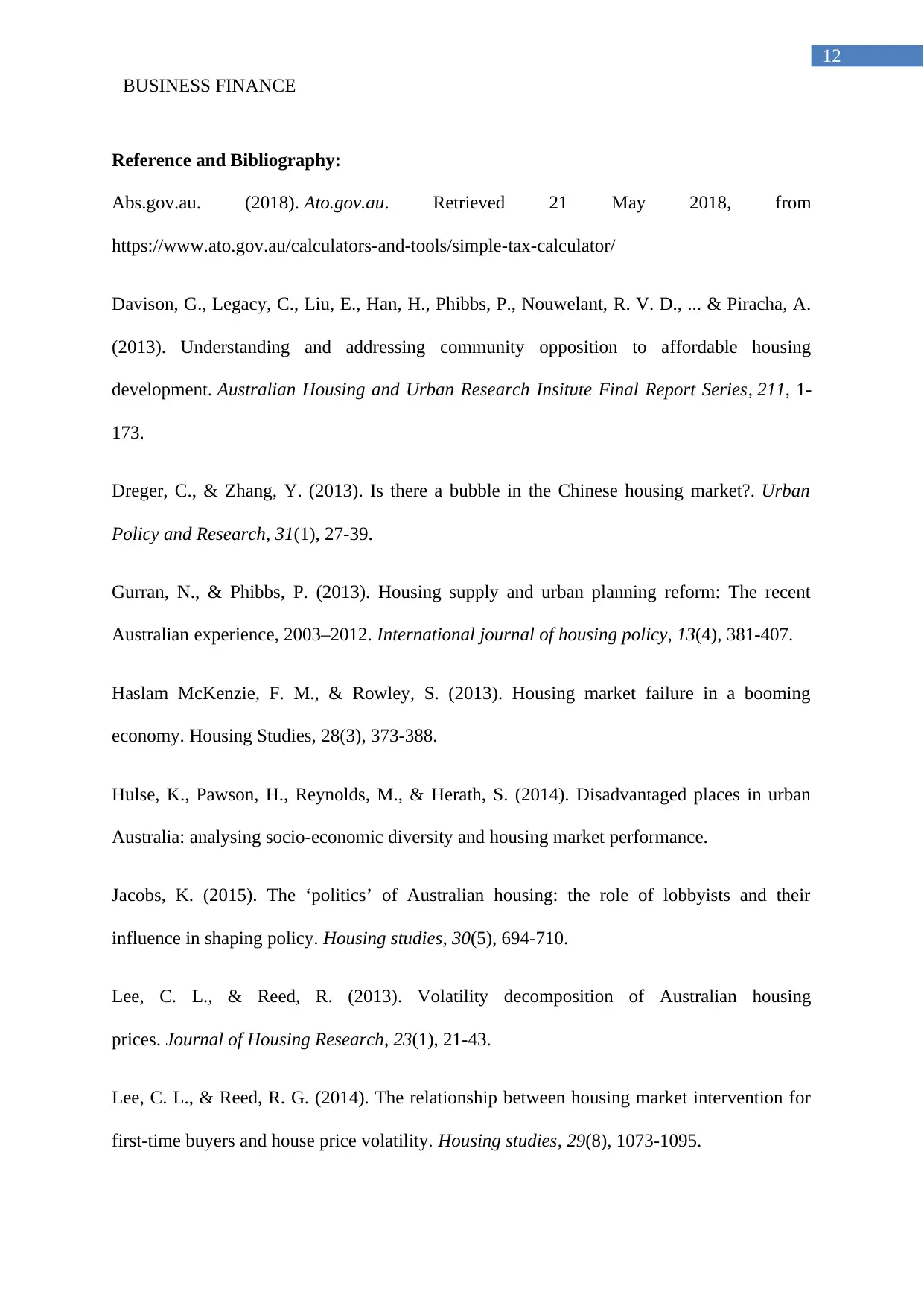
BUSINESS FINANCE
12
Reference and Bibliography:
Abs.gov.au. (2018). Ato.gov.au. Retrieved 21 May 2018, from
https://www.ato.gov.au/calculators-and-tools/simple-tax-calculator/
Davison, G., Legacy, C., Liu, E., Han, H., Phibbs, P., Nouwelant, R. V. D., ... & Piracha, A.
(2013). Understanding and addressing community opposition to affordable housing
development. Australian Housing and Urban Research Insitute Final Report Series, 211, 1-
173.
Dreger, C., & Zhang, Y. (2013). Is there a bubble in the Chinese housing market?. Urban
Policy and Research, 31(1), 27-39.
Gurran, N., & Phibbs, P. (2013). Housing supply and urban planning reform: The recent
Australian experience, 2003–2012. International journal of housing policy, 13(4), 381-407.
Haslam McKenzie, F. M., & Rowley, S. (2013). Housing market failure in a booming
economy. Housing Studies, 28(3), 373-388.
Hulse, K., Pawson, H., Reynolds, M., & Herath, S. (2014). Disadvantaged places in urban
Australia: analysing socio-economic diversity and housing market performance.
Jacobs, K. (2015). The ‘politics’ of Australian housing: the role of lobbyists and their
influence in shaping policy. Housing studies, 30(5), 694-710.
Lee, C. L., & Reed, R. (2013). Volatility decomposition of Australian housing
prices. Journal of Housing Research, 23(1), 21-43.
Lee, C. L., & Reed, R. G. (2014). The relationship between housing market intervention for
first-time buyers and house price volatility. Housing studies, 29(8), 1073-1095.
12
Reference and Bibliography:
Abs.gov.au. (2018). Ato.gov.au. Retrieved 21 May 2018, from
https://www.ato.gov.au/calculators-and-tools/simple-tax-calculator/
Davison, G., Legacy, C., Liu, E., Han, H., Phibbs, P., Nouwelant, R. V. D., ... & Piracha, A.
(2013). Understanding and addressing community opposition to affordable housing
development. Australian Housing and Urban Research Insitute Final Report Series, 211, 1-
173.
Dreger, C., & Zhang, Y. (2013). Is there a bubble in the Chinese housing market?. Urban
Policy and Research, 31(1), 27-39.
Gurran, N., & Phibbs, P. (2013). Housing supply and urban planning reform: The recent
Australian experience, 2003–2012. International journal of housing policy, 13(4), 381-407.
Haslam McKenzie, F. M., & Rowley, S. (2013). Housing market failure in a booming
economy. Housing Studies, 28(3), 373-388.
Hulse, K., Pawson, H., Reynolds, M., & Herath, S. (2014). Disadvantaged places in urban
Australia: analysing socio-economic diversity and housing market performance.
Jacobs, K. (2015). The ‘politics’ of Australian housing: the role of lobbyists and their
influence in shaping policy. Housing studies, 30(5), 694-710.
Lee, C. L., & Reed, R. (2013). Volatility decomposition of Australian housing
prices. Journal of Housing Research, 23(1), 21-43.
Lee, C. L., & Reed, R. G. (2014). The relationship between housing market intervention for
first-time buyers and house price volatility. Housing studies, 29(8), 1073-1095.
Paraphrase This Document
Need a fresh take? Get an instant paraphrase of this document with our AI Paraphraser
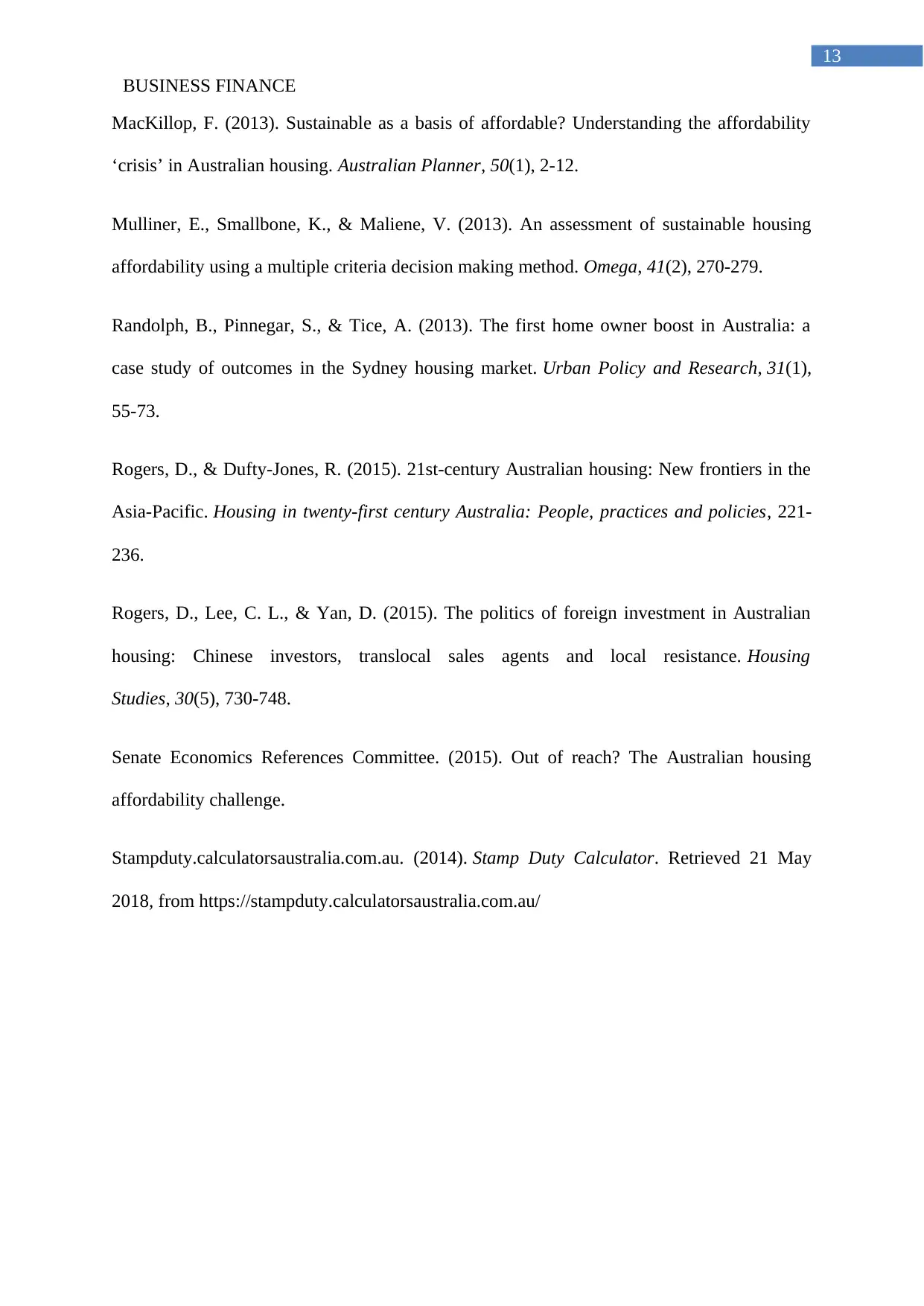
BUSINESS FINANCE
13
MacKillop, F. (2013). Sustainable as a basis of affordable? Understanding the affordability
‘crisis’ in Australian housing. Australian Planner, 50(1), 2-12.
Mulliner, E., Smallbone, K., & Maliene, V. (2013). An assessment of sustainable housing
affordability using a multiple criteria decision making method. Omega, 41(2), 270-279.
Randolph, B., Pinnegar, S., & Tice, A. (2013). The first home owner boost in Australia: a
case study of outcomes in the Sydney housing market. Urban Policy and Research, 31(1),
55-73.
Rogers, D., & Dufty-Jones, R. (2015). 21st-century Australian housing: New frontiers in the
Asia-Pacific. Housing in twenty-first century Australia: People, practices and policies, 221-
236.
Rogers, D., Lee, C. L., & Yan, D. (2015). The politics of foreign investment in Australian
housing: Chinese investors, translocal sales agents and local resistance. Housing
Studies, 30(5), 730-748.
Senate Economics References Committee. (2015). Out of reach? The Australian housing
affordability challenge.
Stampduty.calculatorsaustralia.com.au. (2014). Stamp Duty Calculator. Retrieved 21 May
2018, from https://stampduty.calculatorsaustralia.com.au/
13
MacKillop, F. (2013). Sustainable as a basis of affordable? Understanding the affordability
‘crisis’ in Australian housing. Australian Planner, 50(1), 2-12.
Mulliner, E., Smallbone, K., & Maliene, V. (2013). An assessment of sustainable housing
affordability using a multiple criteria decision making method. Omega, 41(2), 270-279.
Randolph, B., Pinnegar, S., & Tice, A. (2013). The first home owner boost in Australia: a
case study of outcomes in the Sydney housing market. Urban Policy and Research, 31(1),
55-73.
Rogers, D., & Dufty-Jones, R. (2015). 21st-century Australian housing: New frontiers in the
Asia-Pacific. Housing in twenty-first century Australia: People, practices and policies, 221-
236.
Rogers, D., Lee, C. L., & Yan, D. (2015). The politics of foreign investment in Australian
housing: Chinese investors, translocal sales agents and local resistance. Housing
Studies, 30(5), 730-748.
Senate Economics References Committee. (2015). Out of reach? The Australian housing
affordability challenge.
Stampduty.calculatorsaustralia.com.au. (2014). Stamp Duty Calculator. Retrieved 21 May
2018, from https://stampduty.calculatorsaustralia.com.au/
1 out of 14
Related Documents
Your All-in-One AI-Powered Toolkit for Academic Success.
+13062052269
info@desklib.com
Available 24*7 on WhatsApp / Email
![[object Object]](/_next/static/media/star-bottom.7253800d.svg)
Unlock your academic potential
© 2024 | Zucol Services PVT LTD | All rights reserved.





